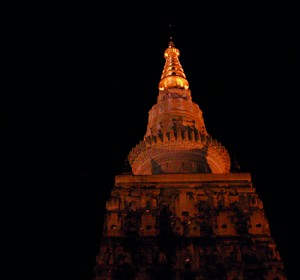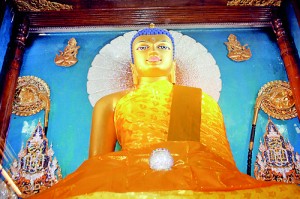Setting foot on sacred soil on Navam Poya day
For 65-year-old K.D.Gnanawathie, a devout Buddhist, a pilgrimage to the Buddhists’ holy lands in Northern India and Nepal was

The illuminated temple pinnacle
something she had for long wanted to make. Her fervent wish was fulfilled recently when she along with a group of 90 others undertook the 12-day pilgrimage which began at Buddha Gaya in the north Indian state of Bihar, the place where Lord Buddha attained enlightenment, the place considered most sacred by Buddhists the world over.
“To have walked on the same land that Lord Buddha walked on and to have felt the dust beneath my feet on the sacred soil during my lifetime, I feel blessed. The experience has left my heart filled with immense joy,” said Gnanawathie, recounting her feelings after undertaking the pilgrimage.
She is among thousands of Sri Lankan Buddhists who annually go on pilgrimage to worship at the sacred sites in India with Buddha Gaya being the most prominent among them.
With direct flights now in operation between Colombo and Buddha Gaya, most pilgrims are spared long hours of train travel from other Indian cities to reach the holy city. The Gaya airport is just five kilometres from the Mahabodhi Temple complex within which is the Sacred Bo-tree (botanical name ficus religiosa) under which Prince Siddhartha Gautama (566-486 BC) ended his long quest for enlightenment. He had left his father’s palace in Kapilavastu (about 550 kilometres north of Gaya) six years earlier searching for a way to end human suffering. It was on reaching Gaya, seated under the shade of the Bo-tree deep in meditation, that the prince turned ascetic reached enlightenment thus earning the title Buddha or the ‘Enlightened One.’
It was during the reign of King Asoka, (around 304–232 BC) the great Mauyran emperor who was instrumental in propagating Buddhism throughout India as well as to other countries in the region, that a stupa was first built at Buddha Gaya in veneration of the Buddha. The vajrasana or diamond throne, the polished sandstone to represent the seat of enlightenment was also set up and remains till today.
The Bo-tree that stands at Buddha Gaya is said to be the fifth descendant plant of the original tree under which the Buddha attained

Inner chamber of the Maha Bodhiya
enlightenment. It was a sapling of that tree, brought to Sri Lanka by Bhikkuni Sangamitta, the daughter of King Asoka around the third century BC that survives at the Sri Maha Bodhiya in Anuradhapura till this day. Since its founding, the Maha

K.D.Gnanawathie: Making the pilgrimage of her life
Bodhiya at Buddha Gaya has come under numerous threats and attacks over the centuries. In July last year, Buddha Gaya suffered its latest attack when a series of bombs exploded within the temple complex. According to Ven. Kahatagollewe Medhankara Thera, the Assistant Bhikku-in-Charge of the Mahabodhi Society of India at the Buddha Gaya Centre, the incident resulted in a drop in Sri Lankan pilgrims to the venerated site for a few months but with additional security systems put in place, there is once again an increase in the numbers visiting.
“The Government of Bihar has installed metal detectors since the attack and will soon introduce more sophisticated security equipment so as not to inconvenience visitors,” the Thera said. As the Mahabodhi Mahavihara was declared a World Heritage Site by the UNESCO in June 2002, the preservation and security of the site also has drawn international attention, he said.
With the serene and overwhelming feeling of spirituality one experiences on entering the temple complex, fear is an alien feeling and the veneration around the Bodhiya continues as was evident on Navam Full Moon day as a group of us made our way to the Maha Bodhiya at Buddha Gaya.
The temperature had fallen to around 8 degrees centigrade, but that did not deter the hundreds of pilgrims from all parts of the world including many from Sri Lanka from walking barefooted around the large temple complex, visiting the seven places where the Buddha sat in meditation after the attainment of Enlightenment. Many meditated around the Bo-tree while others walked around. The chanting of prayers filled the cold full moon night as Buddhists from different countries prayed in their own unique ways. Lamps lit up the Maha

Pilgrims at Buddha Gaya
Bodhi complex and the smell of flowers filled the air as devotees prayed in harmony, each enthralled in the moment but also feeling blessed to be in the same place that Lord Buddha attained enlightenment and from thereon began his universal discourse starting with the Dhammacakkappavattana Sutta which has since been embraced by millions of people worldwide.
As for Gnanawathi and many others who made the pilgrimage, the experience has made their faith stronger. “All I knew about these places was from what I have read and heard but setting foot on the sacred land of Lord Buddha and seeing for myself the places that the Enlightened One spent his life in, has reinforced my faith in the Dhamma,” she said.
The writer was part of a familiarisation tour organised by the Indian Ministry of External Affairs



